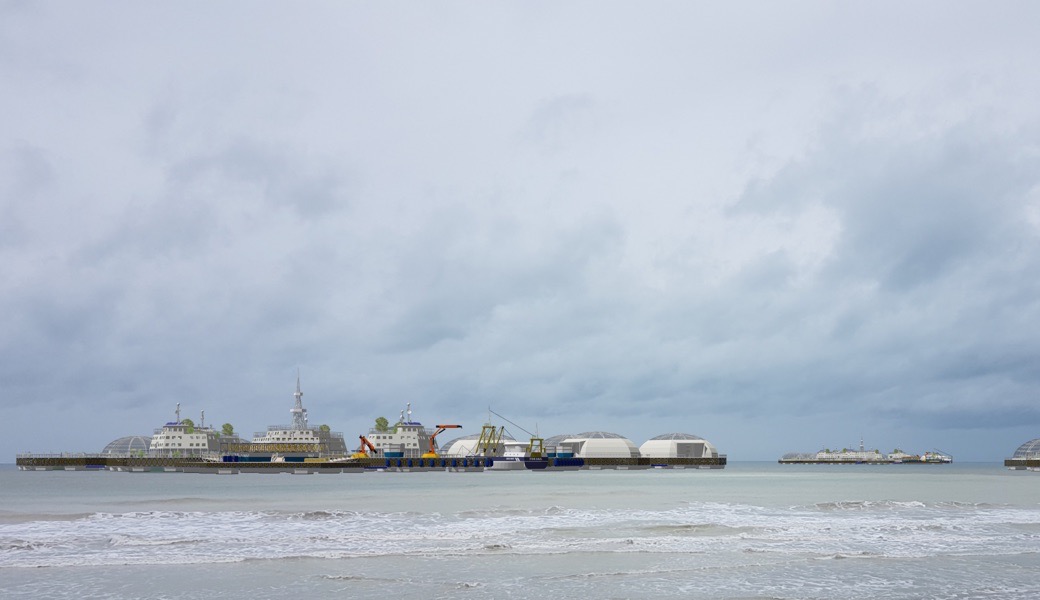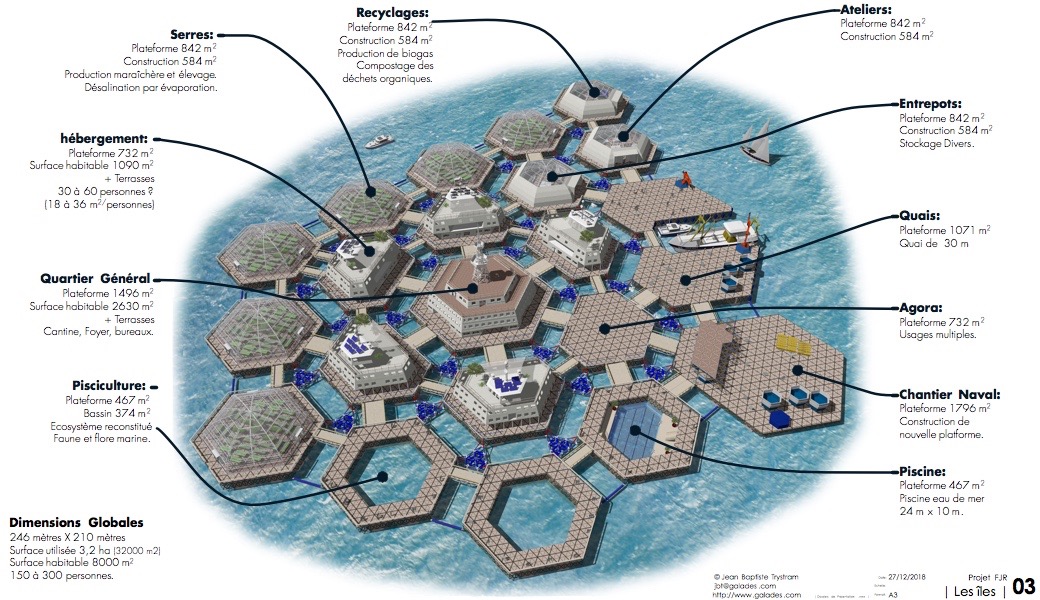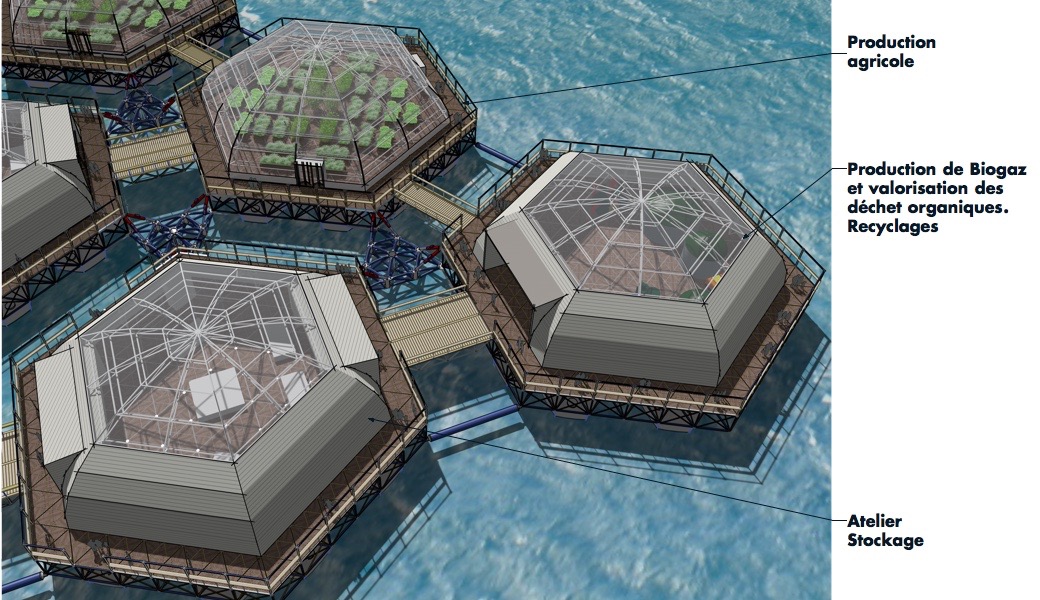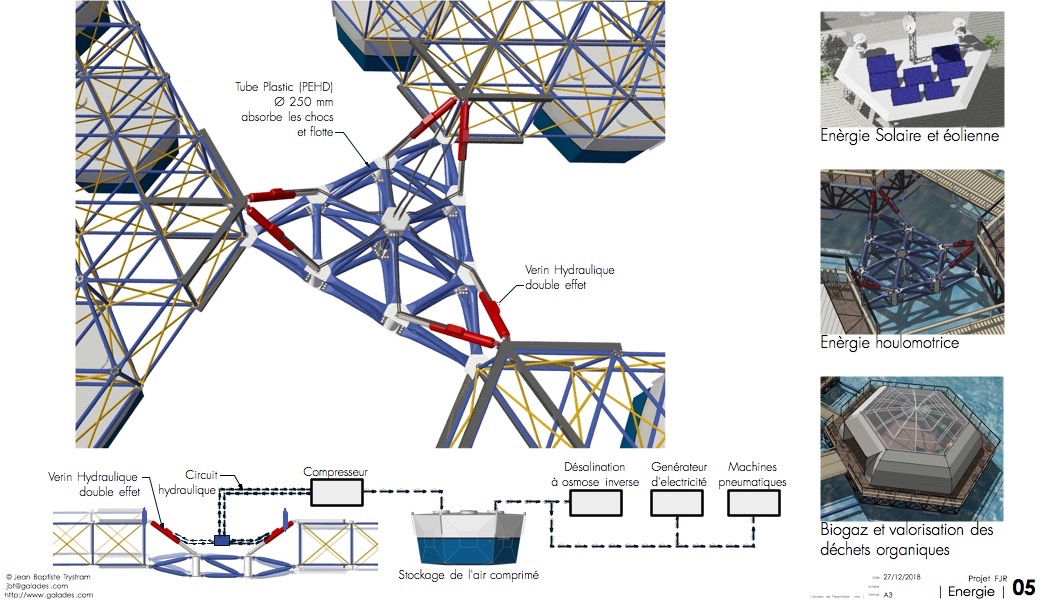Building islands in kit form. a self-sufficient island.
The project presents both a floating arch island and a system for its construction. The island responds to a need to experiment with a collective life at sea, ecological, self-sufficient, adaptive, a kind of laboratory. The system, due to its modularity, simplicity and reasonable cost, makes it possible to build this island in the very near future.
The island covers an area of 3.2 ha on the sea, divided into 22 platforms of about 850 m2. Each platform is connected to adjacent platforms by connection modules using oscillating movements caused by the swell to generate energy stored as compressed air. This compressed air is then used to generate electricity, desalinate water by reverse osmosis, activate pneumatic machines and manage ballast systems that may be required. This system avoids the low efficiency of battery storage.
The project presents both a floating arch island and a system for its construction. The island responds to a need to experiment with a collective life at sea, ecological, self-sufficient, adaptive, a kind of laboratory. The system, due to its modularity, simplicity and reasonable cost, makes it possible to build this island in the very near future.
The island covers an area of 3.2 ha on the sea, divided into 22 platforms of about 850 m2. Each platform is connected to adjacent platforms by connection modules using oscillating movements caused by the swell to generate energy stored as compressed air. This compressed air is then used to generate electricity, desalinate water by reverse osmosis, activate pneumatic machines and manage ballast systems that may be required. This system avoids the low efficiency of battery storage.
Photovoltaic and wind power systems complete the energy production.
Bridges, adapted to the movement of the platforms, connect them.
It should house 150 to 300 people, 3500 m2 of agricultural greenhouses, fish farming ponds, a composting and biogas production station and various functions necessary for a community (docks, warehouses, workshop, etc.).
One platform allows to build other platforms in order to expand the island's capacities or create another one.
A central building houses a kitchen, canteen, offices, foyer, laboratories, etc.
The island offers a prime location for in situ experiments on sedentary life at sea.
Bridges, adapted to the movement of the platforms, connect them.
It should house 150 to 300 people, 3500 m2 of agricultural greenhouses, fish farming ponds, a composting and biogas production station and various functions necessary for a community (docks, warehouses, workshop, etc.).
One platform allows to build other platforms in order to expand the island's capacities or create another one.
A central building houses a kitchen, canteen, offices, foyer, laboratories, etc.
The island offers a prime location for in situ experiments on sedentary life at sea.
ein Bausatz um Inseln zu bauen. als Beispiel eine autarke Insel.
Das Projekt umfasst sowohl eine schwimmende Bogeninsel als auch ein System zu deren Bau. Diese "Insel" reagiert auf die Notwendigkeit, mit einem kollektiven Leben auf See zu experimentieren, ökologisch, autark, anpassungsfähig, ein Labor. Das System ermöglicht es, aufgrund seiner Modularität, Einfachheit und Kostengünstigkeit, diese Insel in naher Zukunft zu bauen.
Die Insel erstreckt sich auf einer Fläche von 3,2 ha am Meer, aufgeteilt in 22 Plattformen von ca. 850 m2. Jede Plattform ist über Anschlussmodule mit benachbarten Plattformen verbunden, durch den Wellengang verursachte oszillierende Bewegungen Energie erzeugen, die als Druckluft gespeichert ist. Aus dieser Druckluft wird dann Strom erzeugt, Wasser durch Umkehrosmose entsalzt, pneumatische Maschinen aktiviert und gegebenenfalls Ballastsysteme gesteuert. Dieses System vermeidet die geringe Effizienz der Batteriespeicherung. Photovoltaik- und Windkraftanlagen runden die Energieerzeugung ab.
Das Projekt umfasst sowohl eine schwimmende Bogeninsel als auch ein System zu deren Bau. Diese "Insel" reagiert auf die Notwendigkeit, mit einem kollektiven Leben auf See zu experimentieren, ökologisch, autark, anpassungsfähig, ein Labor. Das System ermöglicht es, aufgrund seiner Modularität, Einfachheit und Kostengünstigkeit, diese Insel in naher Zukunft zu bauen.
Die Insel erstreckt sich auf einer Fläche von 3,2 ha am Meer, aufgeteilt in 22 Plattformen von ca. 850 m2. Jede Plattform ist über Anschlussmodule mit benachbarten Plattformen verbunden, durch den Wellengang verursachte oszillierende Bewegungen Energie erzeugen, die als Druckluft gespeichert ist. Aus dieser Druckluft wird dann Strom erzeugt, Wasser durch Umkehrosmose entsalzt, pneumatische Maschinen aktiviert und gegebenenfalls Ballastsysteme gesteuert. Dieses System vermeidet die geringe Effizienz der Batteriespeicherung. Photovoltaik- und Windkraftanlagen runden die Energieerzeugung ab.
Brücken, die an die Bewegung der Plattformen angepasst sind, verbinden sie.
Die Insel sollte 150 bis 300 Menschen beherbergen, 3500 m2 landwirtschaftliche Gewächshäuser, Fischzuchtbecken, eine Kompostierungs- und Biogasproduktionsstation und verschiedene Funktionen, die für eine Gemeinde notwendig sind (Docks, Lager, Werkstätten usw.).
Eine Plattform ermöglicht es, andere Plattformen zu bauen, um die Kapazitäten der Insel zu erweitern oder eine andere zu schaffen.
Ein zentrales Gebäude beherbergt eine Küche, Kantine, Büros, Foyer, Labore, etc.
Die Insel bietet einen erstklassigen Standort für In-situ-Experimente über das Leben auf See.
Die Insel sollte 150 bis 300 Menschen beherbergen, 3500 m2 landwirtschaftliche Gewächshäuser, Fischzuchtbecken, eine Kompostierungs- und Biogasproduktionsstation und verschiedene Funktionen, die für eine Gemeinde notwendig sind (Docks, Lager, Werkstätten usw.).
Eine Plattform ermöglicht es, andere Plattformen zu bauen, um die Kapazitäten der Insel zu erweitern oder eine andere zu schaffen.
Ein zentrales Gebäude beherbergt eine Küche, Kantine, Büros, Foyer, Labore, etc.
Die Insel bietet einen erstklassigen Standort für In-situ-Experimente über das Leben auf See.
Construire des îles en kit. une île auto-suffisante.
Le projet présente à la fois une île-arche flottante et un système permettant de construire celle-ci. l’île répond à un besoin d’expérimentation d’une vie collective en mer, écologique, auto-suffisante, adaptative, un laboratoire en quelque sorte. Le système, de part sa modularité, sa simplicité et son coût raisonnable permet de construire cette île dans un futur très proche.
L’île occupe une surface de 3,2 ha sur la mer, répartie en 22 plateformes d’environ 850 m2. Chaque plateforme est connectée aux plateformes adjacentes par des modules de connexion utilisant les mouvements oscillants causé par la houle pour générer de l’énergie stockée sous forme d’air comprimé. Cette air comprimé est ensuite utilisé pour générer de l’électricité, dessaler l’eau par osmose inverse, activer des machines pneumatiques et gérer les systèmes de ballast qui peuvent être nécessaires. Ce système évite le faible rendement d’un stockage par batterie. Des systèmes photovoltaïques et éoliens complètent la production d’énergie.
Le projet présente à la fois une île-arche flottante et un système permettant de construire celle-ci. l’île répond à un besoin d’expérimentation d’une vie collective en mer, écologique, auto-suffisante, adaptative, un laboratoire en quelque sorte. Le système, de part sa modularité, sa simplicité et son coût raisonnable permet de construire cette île dans un futur très proche.
L’île occupe une surface de 3,2 ha sur la mer, répartie en 22 plateformes d’environ 850 m2. Chaque plateforme est connectée aux plateformes adjacentes par des modules de connexion utilisant les mouvements oscillants causé par la houle pour générer de l’énergie stockée sous forme d’air comprimé. Cette air comprimé est ensuite utilisé pour générer de l’électricité, dessaler l’eau par osmose inverse, activer des machines pneumatiques et gérer les systèmes de ballast qui peuvent être nécessaires. Ce système évite le faible rendement d’un stockage par batterie. Des systèmes photovoltaïques et éoliens complètent la production d’énergie.
Des passerelles, adaptées au mouvement des plateformes, relient celles-ci.
L’île devrait abriter 150 à 300 personnes, 3500 m2 de serres agricoles, des bassins de pisciculture, une station de compostage et production de biogaz et différentes fonctions nécessaires à une collectivité (quais, entrepôts, atelier etc.).
Une plateforme permet de construire d’autres plateformes afin d’agrandir les capacités de l’île ou dans créer une autres.
Un bâtiment central abrite cuisine, cantine, bureaux, foyer, laboratoires, etc.
L’île offre une place de choix pour mener des expérimentations in situ sur la vie sédentaire en mer.
L’île devrait abriter 150 à 300 personnes, 3500 m2 de serres agricoles, des bassins de pisciculture, une station de compostage et production de biogaz et différentes fonctions nécessaires à une collectivité (quais, entrepôts, atelier etc.).
Une plateforme permet de construire d’autres plateformes afin d’agrandir les capacités de l’île ou dans créer une autres.
Un bâtiment central abrite cuisine, cantine, bureaux, foyer, laboratoires, etc.
L’île offre une place de choix pour mener des expérimentations in situ sur la vie sédentaire en mer.











